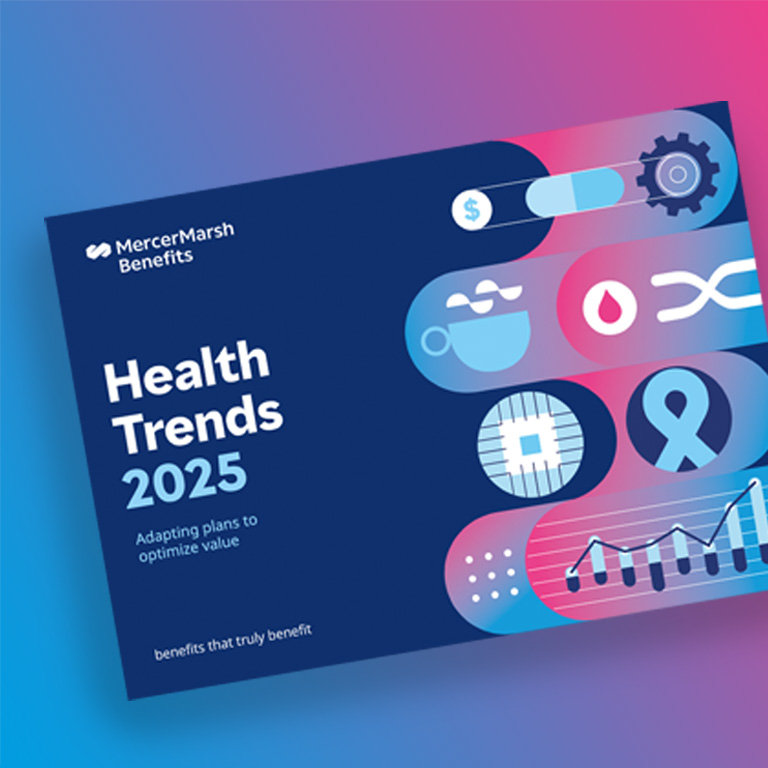
Helena Zikova
Sales Leader, Continental Europe, Mercer Marsh Benefits
-
Austria
Mercer Marsh Benefits (MMB) Health on Demand 2023 research reveals that almost half (47%) of employees feel stressed in their everyday lives and more than half (52%) have worked in the past year while feeling mentally unwell.
Clearly, this situation is unsustainable. Mental health challenges are associated with many negative outcomes in the workplace, including poor morale and lowered employee engagement, increased rates of sickness absence, and higher rates of staff turnover. It also leads to a higher number of direct health insurance claims and increased premiums.
Employers are trusted providers of care and support, and they should use this position to help boost the resilience and overall well-being of their staff. Our research shows the impact that a caring employer can make: employees who feel supported by their employer are 15 percentage points less likely to report feeling stressed in everyday life, while more than three-quarters (78%) of those who believe their employer cares about their well-being report thriving in their current role and organisation.
Employers are uniquely positioned to reduce risks and improve access to support systems. Leaving mental health up to individuals is not enough. So, what can employers do to support employees and reduce the incidence – and impact – of mental ill health?
We recommend the following three actions:
The most important step that employers can take is to make sure everyone in the workforce – from senior leaders to new starters – knows the importance of good mental health. This can be achieved through training and improved communications – and there is evidence that organisations are making some progress for example, 30% of employees say their employer provides training to recognise and address mental health challenges in themselves and others.
However, there is still more work to do. Senior and line managers should be trained and prepared to have empathetic, supportive conversations with employees around mental health. And organisations also need to be aware of which employee groups may need more support. For example, employees who identify as LGBTQ+ are significantly more likely to experience anxiety and depression and are more likely to report working while mentally unwell, while employees with caregiving responsibilities are more likely to be stressed in everyday life than non-caregivers. Understanding the pressures experienced by different segments of the workforce will allow employers to better support to their particular needs.
Increasing awareness of mental health, and removing the stigma from conversations about issues such as anxiety and depression, are important. But to make a real difference, employers need to take root-and-branch action on the underlying causes of workplace stress. This means addressing issues such as job design, work culture, and supervisor competencies. At present, just 53% of employees believe their employers consider well-being in job design – we need the other half to take action too.
Job demands are a major risk factor for mental ill health: work pressures, poor leadership, and toxic culture are the main reasons cited for potential employee burnout.
To mitigate mental health risks, HR and risk professionals should tackle these issues. Problems to look for include unhealthy work hours, isolation, a toxic blame culture, lack of control, and even bullying and harassment.
Currently, only 37% of employers say they will design work with well-being in mind, such as ensuing realistic workloads, reducing complexity, and implementing no-meeting days. That figure needs to rise.
Finally, employers should put in place employee benefits designed to fully support mental well-being.
When an employee has mental health problems, it is vital they have quick and easy access to good-quality treatment. The longer someone is off work due to ill health, the less likely they are to return. Getting them back to work – even in a reduced capacity – accelerates recovery, retains knowledge, and reduces costs.
Health insurance plans can be important here, and it is encouraging to see a growing number of insurers including mental health treatment in their plans – just 16% exclude mental health services from their schemes, down from 26% in 2022. And four in ten (40%) insurers now provide access to virtual mental health counselling, up from one in three (33%) in 2022. However, employers need to make better use of the plans offered by insurers: globally, only 27% of employees say that their employer provides access to mental health counselling services. They also need to improve the inclusivity of such programs: currently, just 22% of employees in lower-income categories report having access to employer-facilitated mental health counselling services, compared to 30% of higher-earning colleagues.
However, treatment is just one side of the coin. To truly support mental well-being, employers should also focus on preventative benefits, ensuring cover for programs designed to assist with managing stress, anxiety, and relationships. Today, health insurance coverage is lacking in this area; for example, preventative coaching is supported by only around one-quarter of insurers globally.
Employee mental health is a critical issue that employers should address to ensure the well-being of their workforce and the success of their organisation. By increasing awareness of mental health, considering the design of work, and providing access to comprehensive mental health-related benefits, employers can boost the resilience and well-being of their most critical asset – their people.
Steps that employers can take now to improve the mental health of their workforce include:

Sales Leader, Continental Europe, Mercer Marsh Benefits
Austria

Total Health Management Business Leader, Mercer Marsh Benefits
Canada

Report
23/04/2024

Article
13/10/2024